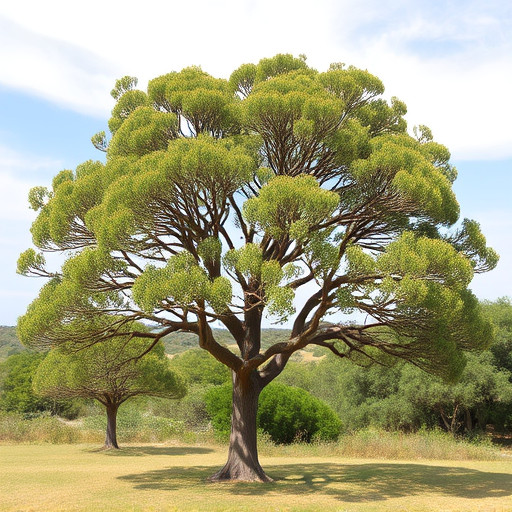The Acacia tree, native to both California and India, exhibits striking differences driven by regional climate variations. In California, Acacias have deep roots for drought resistance and dense canopies, while Indian varieties grow taller with robust root systems adapted to warm, dry conditions. Both types play distinct ecological roles—preventing soil erosion, providing habitat, and offering medicinal benefits in California, versus timber, fuelwood, and fodder sources in India. These regional adaptations reflect their unique life histories shaped by differing environments.
The Enigma of California’s Acacia: A Comparative Journey
The Acacia tree, a genus renowned for its diverse species, presents striking variations across geographical boundaries. This article delves into the enigmatic California Acacia and its unique characteristics compared to its counterpart from India. We explore the adaptation strategies of the former in contrast to the traditional uses and botanical distinctiveness of the latter. Through a comparative lens, we analyze climate influences on their growth patterns, revealing the ecological roles these trees play in their respective regions, alongside their cultural significance.
- California's Acacia: Unique Features and Adaptation
- Indian Acacia: Traditional Uses and Botanical Description
- Comparative Analysis: Climate and Growth Patterns
- Ecological Role and Cultural Significance in Their Respective Regions
California's Acacia: Unique Features and Adaptation

The Acacia tree native to California boasts several unique features and adaptations that set it apart from its Indian counterpart. One striking difference lies in their appearance; California’s Acacias often display a more diverse range of sizes, shapes, and colors, with some species reaching impressive heights and showcasing intricate leaf structures. These variations are a result of the state’s varied climates and environments, allowing for genetic diversity within the species.
Moreover, the Californian Acacia has developed specific mechanisms to thrive in its arid and semi-arid habitats. Their deep taproots help access water sources deep beneath the surface, enabling them to withstand prolonged droughts. Additionally, their waxy leaves reduce water loss through transpiration, ensuring survival during California’s hot and dry summers. These adaptations make the state’s Acacia trees resilient and well-suited to their native environment.
Indian Acacia: Traditional Uses and Botanical Description

The Acacia genus, encompassing various species, has deep-rooted traditional uses in India. For centuries, different parts of the Indian Acacia have been utilized for their medicinal properties. The bark, leaves, and gum have been part of Ayurvedic practices, offering remedies for various ailments. The tree’s hard, durable wood has also found applications in construction and furniture making.
Botanically, Indian Acacia species are characterized by their small, compound leaves with numerous pairs of leaflets. They often grow as shrubs or small trees, reaching heights up to 10 meters. These plants are known for their deep-rooted systems, allowing them to thrive in arid and semi-arid regions. The flowers, typically small and yellow, grow in clusters, adding a vibrant display during the blooming season.
Comparative Analysis: Climate and Growth Patterns

The climate and growth patterns of the Acacia tree vary significantly between California and India, leading to distinct characteristics. California’s Mediterranean climate, characterized by mild, wet winters and warm, dry summers, supports a diverse range of plant life but poses unique challenges for Acacia species. These trees have adapted to this environment by developing deep root systems that can access groundwater during droughts and dense canopies to minimize water loss through transpiration. In contrast, Indian Acacias thrive in the country’s diverse climatic zones, from arid deserts to tropical regions. The warm, dry conditions in many parts of India favor rapid growth, resulting in taller, more robust trees with wider spreads compared to their California counterparts. The Indian varieties have also evolved to withstand periodic drought and extreme temperatures, showcasing remarkable resilience.
These differences in climate influence not only the physical attributes of the trees but also their ecological roles. In California, Acacia species play a crucial role in preventing soil erosion and providing habitat for various wildlife. Their adaptive strategies enable them to thrive in fragmented habitats, such as chaparral and oak woodlands. In India, Acacias contribute to the overall biodiversity, serving as food sources for both animals and birds and playing a vital role in stabilizing sandy soils in desert regions. The varying growth patterns and environmental pressures have shaped these trees’ life histories, leading to distinct ecological footprints and contributions to their respective ecosystems.
Ecological Role and Cultural Significance in Their Respective Regions

The Acacia tree, native to both California and India, serves distinct ecological roles and holds cultural significance in each region. In California, Acacias are integral to the state’s diverse ecosystems, providing habitat and food for various wildlife species. Their deep roots help prevent soil erosion, while their dense foliage offers shade and shelter. Many indigenous communities in California have traditionally used different parts of the Acacia tree for medicinal purposes and as a source of food and materials, deeply embedding it within their cultural heritage.
In contrast, Indian Acacias play a crucial role in the country’s agroforestry practices, particularly for their ability to thrive in arid and semi-arid regions. They are cultivated extensively for their timber, which is valued for its strength and durability. Moreover, they contribute significantly to soil stabilization and conservation, enhancing agricultural productivity. Indian cultures, notably those in rural areas, have long recognized the Acacia’s value as a source of fuelwood, fodder, and even traditional medicine, leading to deep cultural connections and practical uses.
The Acacia tree, distinct in its adaptation to California’s climate, showcases unique growth patterns and an ecological role that set it apart from its Indian counterpart. While the Indian Acacia holds cultural significance and traditional uses, the Californian variety has evolved specific traits enabling it to thrive in its distinct environment. This comparative study highlights the diverse manifestations of Acacia species worldwide, emphasizing the importance of understanding local adaptations for conservation and sustainable practices.
